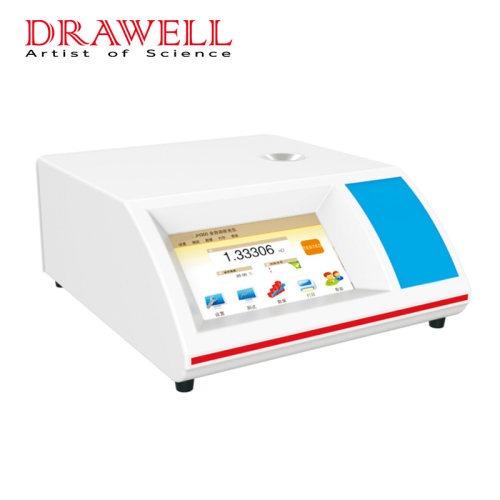Refractometers are essential tools in various industries, including food and beverage, agriculture, and manufacturing. They measure the refractive index of a liquid, which is a measure of how much light bends as it passes through the liquid. This information can be used to determine the concentration of dissolved solids, such as sugar, salt, or protein, in a solution.
There are two main types of refractometers: hand refractometers and digital refractometers. Each type has its own advantages and disadvantages, making the choice between them depend on your specific needs and application. This guide will explore the differences between these two types of refractometers, helping you make an informed decision for your laboratory or industrial setting.
Hand Refractometers: A Classic Approach
Hand refractometers, also known as analog refractometers, are traditional instruments that rely on a visual measurement of the refractive index. They typically consist of a prism, a lens, and a scale.
To use a hand refractometer, a few drops of the sample are placed on the prism. The user then looks through the lens and observes the boundary between the light and dark areas on the scale. The refractive index is read directly from the scale.
Here are some key advantages of hand refractometers:
Simplicity and Affordability: Hand refractometers are relatively simple to use and are generally more affordable than digital refractometers. They are a good option for basic measurements and for applications where portability is important.
Portability: Hand refractometers are compact and portable, making them suitable for field use or for applications where space is limited.
Durability: Hand refractometers are typically robust and durable, able to withstand harsh environments and rough handling.
However, hand refractometers also have some limitations:
Subjectivity: The measurement process can be subjective, as the user must visually interpret the boundary line on the scale. This can lead to variations in readings between different users.
Limited Accuracy: Hand refractometers typically have a lower accuracy compared to digital refractometers. The precision of the measurement is limited by the resolution of the scale and the user's ability to accurately interpret the boundary line.
Temperature Sensitivity: The refractive index of a liquid is temperature-dependent. Hand refractometers often lack temperature compensation, which can lead to inaccuracies in measurements, especially in environments with fluctuating temperatures.
Digital Refractometers: Precision and Automation
Digital refractometers utilize advanced technology to provide more precise and automated measurements. They typically consist of a light source, a prism, a sensor, and a digital display.
A digital refractometer works by shining a beam of light through the sample and measuring the angle of refraction. The sensor then converts this information into a digital reading, which is displayed on the LCD screen.
Here are some key advantages of digital refractometers:
Higher Accuracy and Precision: Digital refractometers offer significantly higher accuracy and precision compared to hand refractometers. The digital sensor provides a more objective and repeatable measurement, reducing the potential for user error.
Automated Measurement: Digital refractometers automate the measurement process, eliminating the need for visual interpretation. This makes the measurement process faster and more efficient, especially for high-volume applications.
Temperature Compensation: Most digital refractometers include automatic temperature compensation (ATC), which corrects for variations in temperature and ensures accurate measurements across a range of temperatures.
Data Logging and Connectivity: Many digital refractometers have data logging capabilities, allowing you to store and analyze measurements over time. Some models also offer connectivity options, such as USB or Bluetooth, for transferring data to a computer or other devices.
However, digital refractometers also have some drawbacks:
Higher Cost: Digital refractometers are generally more expensive than hand refractometers. The advanced technology and features come at a higher price tag.
Less Portability: Digital refractometers are typically larger and less portable than hand refractometers. They may not be suitable for field use or for applications where space is limited.
Power Requirements: Digital refractometers often require a power source, such as batteries or an AC adapter. This can be a limitation in situations where power is not readily available.
Choosing the Right Refractometer for Your Needs
The choice between a hand refractometer and a digital refractometer depends on your specific application and requirements. Here's a breakdown of factors to consider:
Accuracy and Precision: If you require highly accurate and precise measurements, a digital refractometer is the better choice. For applications where a lower level of accuracy is acceptable, a hand refractometer may suffice.
Frequency of Use: If you'll be using the refractometer frequently, a digital refractometer can save time and effort with its automated measurement capabilities. For occasional use, a hand refractometer may be a more cost-effective option.
Portability: If you need a portable refractometer for field use, a hand refractometer is the better choice. For laboratory settings or applications where portability is not a major concern, a digital refractometer offers more features and accuracy.
Budget: Hand refractometers are generally more affordable than digital refractometers. Consider your budget and the level of accuracy and features you require.
Temperature Compensation: If you're working in an environment with fluctuating temperatures, a digital refractometer with automatic temperature compensation is recommended. Hand refractometers may not offer this feature.
Data Logging and Connectivity: If you need to store and analyze measurements over time, a digital refractometer with data logging capabilities is a good choice. Some models also offer connectivity options for transferring data to a computer or other devices.
Drawellanalytical: Your Trusted Source for Refractometers
Drawellanalytical offers a wide range of high-quality refractometers, including both hand and digital models. We are committed to providing our customers with the best possible solutions for their specific needs.
Our digital refractometers, such as our automatic digital refractometer, are designed for accuracy, precision, and ease of use. We also offer a variety of hand refractometers for basic measurements and portable applications.
Contact Drawellanalytical today to discuss your refractometer needs and find the perfect solution for your laboratory or industrial setting.









Share this page with your family and friends.